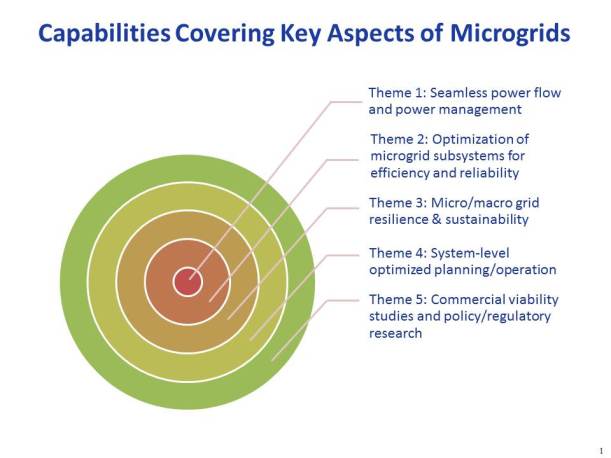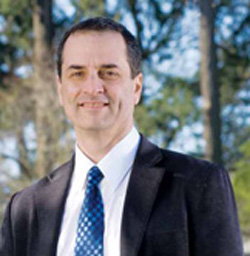(Part 1 of this two-part blog looked at how a unique Adaptation amendment to UConn’s Climate Action Plan, approved by President Herbst in 2012, created a roadmap that has helped guide UConn to a leadership position on resiliency research and public service, especially with the creation of the ICRCA at Avery Point. Part 2 focuses on adaptation research, from clean energy microgrids to roadside forestry, with a preview of the half-day CIMA3 conference on March 31st.)
UConn’s Microgrid – A Model for Clean and Resilient Energy Infrastructure
Most residents in the state will remember the challenges of being without electricity for up to 10 days in the aftermath of at least one of the major storms we’ve experienced in recent years. In response, Connecticut now leads the nation with its innovative microgrid program, which once again features UConn as a key player and potentially as a statewide center of excellence. Under its three phase, multi-year microgrid program, DEEP provides grant funding for high-tech switchgear, independent distribution systems and automated controls that enable on-site, efficient, and preferably clean, energy-generating sources to operate in “island mode,” separate from the utility-owned grid.
Last year, UConn was in the initial group of nine, including municipalities, hospitals and other college campuses, to receive a phase one incentive grant. In our case, $2.14 million in funding will be used to convert our 400 kW ClearEdge fuel cell, a source of combined heat and power to most of the UConn-owned and occupied buildings at the Depot, along with a small PV solar array, into a clean energy microgrid. In turn, when this system is installed and operating this fall, it will ensure continuous power to certain facilities that can meet public needs during extended grid power outages, like electric vehicle charging stations, a communications command center for UConn police and fire departments, and community warming centers, with kitchens and restrooms.
Installed in 2012, the fuel cell generates heat and power through an electrochemical reaction, similar to a battery, not through combustion. Our Depot Campus fuel cell reduces UConn’s carbon footprint by more than 800 tons a year compared to receiving power from the grid or using more conventional fuel-burning sources of energy. Thus, UConn’s microgrid not only makes for a more resilient and reliable energy infrastructure but also helps promote the use of cleaner, renewable, and more efficient energy sources.
Beyond these immediate operational and public benefits, UConn’s microgrid will be another example of a state-of-the-art “living laboratory,” i.e., an on-campus platform for research and a functional demonstration project for education and outreach. Already, a half-dozen faculty members affiliated with the University’s Center for Clean Energy Engineering (C2E2), led by Dr. Peter Luh in Electrical & Computer Engineering, are preparing and envisioning research grant proposals on hot microgrid topics like energy storage, advanced optimization and ultra-fast programmable networks for virtual energy management.

There is yet another benefit to UConn for being on the cutting edge of this emerging microgrid technology: corporate R&D partnerships. On February 26th, nearly 60 people, representing dozens of potential industry partners, in Hartford for a three-day “Next Generation Microgrids” conference, visited the Depot for presentations and tours of the University’s C2E2 and recently-established Fraunhofer Center for Energy Innovation. This visit was an opportunity to further showcase UConn’s leadership in these important aspects of climate adaptation and sustainable energy. The audience was a representative cross-section of the energy industry, including small and large, regional and international companies, all with an interest in microgrid R&D. The conference brochure touted a “staggering growth” since 2011 in installed microgrid capacity worldwide, with a “market value…likely to reach up to $27 billion by 2022.”
Plenty of good reasons for UConn to stay at the forefront of microgrid research!
UConn Research Helping Connecticut Adapt to Climate Change
Meanwhile, there are many University faculty members, across a variety of disciplines, who are conducting adaptation-related research. To highlight just a few:
- Dr. Mark Boyer, a Political Science professor who focuses on environmental politics and is the director of UConn‘s new Environmental Studies B.A. degree program, is looking at the drivers and barriers to local governance of climate change. In particular, he’s studied climate adaptation policies, ordinances and other initiatives adopted by Connecticut towns.
- Dr. Manos Anagnostou (Environmental Engineering/ENVE), Dr. Brian Hartman (Math), Dr. Marina Astitha (ENVE) and PhD candidate Dave Wanik (ENVE) are working on weather-based damage prediction models for the electric distribution system in CT and MA. The models relate high resolution weather forecasts, distribution infrastructure and GIS data to historic damage observations, and will soon include tree trimming data as a model input.
- Related research into mitigating tree failure by Drs. Mark Rudnicki, John Volin (Natural Resources & the Environment) and Thomas Worthley (Extension) will further enhance reliability of the grid through management of trees and forest edges near power lines. Part of their “Stormwise” initiative was recently featured in this Hartford Courant article and this report on WNPR. The total Stormwise initiative is developing a systems approach which integrates the biophysical, economic and social dimensions needed for successfully increasing the resilience of trees, forests and the utility infrastructure to expected future storms. Follow them @StormwiseUCONN
Also, led by Dr. Jim Edson (Marine Sciences), nearly two dozen faculty members in UConn’s inter-disciplinary Atmospheric Sciences Group, along with affiliated graduate Research Assistants, met last month to discuss their climate change-related research. Many are studying the impacts of climate change on everything from terrestrial biota, to coastlines, estuaries and oceans. Much of this research is intended to provide data that will guide the development of mitigation and adaptation strategies, pursuant to the mission of UConn’s new Institute for Community Resiliency and Climate Adaptation.
You can learn more about this research by attending UConn’s third annual Climate Impact Mitigation & Adaptation (CIMA3) conference, scheduled for March 31st at the Student Union Theater and in the SU’s Room 104, across from Chuck & Auggie’s and the Blue Cow.
By Rich Miller, Director of the Office of Environmental Policy (OEP) and Kerrin Kinnear, OEP intern (4th semester, ENVST)
CIMA3/2014
Rapid Responses to Climate Change: The Actions We Need To Take
- 9:00 – Introductory remarks by Provost Mun Choi
- 9:15 – Keynote address from Curt Spalding, EPA’s top official in New England
- 10:00 – A panel of TED talks on the impacts of climate change on environmental systems, featuring a variety of UConn faculty experts
- 11:30 – 1:00 – The “CIMA Café” & Plain-Language Poster Session – a free networking lunch – enjoy finger food from Dining Services’ sustainable catering menu as you mingle with other students, faculty and staff during a “plain language” poster session explaining CIMA-related UConn research, centers and programs
- 12:30 – Closing plenary remarks by Dr. Eban Goodstein, Director of Bard College’s Center of Environmental Policy and Sustainability MBA, best known as lead organizer of Power Shift, Focus the Nation, 350.org and other higher ed-focused climate action initiatives.
- 1:30 – Conference concludes
Come and see for yourself what makes UConn a leader in Climate Adaptation! For more information about the event, please contact UConn’s Office of Environmental Policy at (860) 486-5773.

